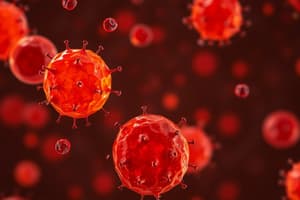Podcast
Questions and Answers
What are melanocytes?
What are melanocytes?
- Cells that produce sebum
- Cells that contain melanin (correct)
- Cells that make skin waterproof
- Cells that form blood vessels
What is pigmentation?
What is pigmentation?
Color
Define angiogenesis.
Define angiogenesis.
Formation of blood vessels
What do sebaceous glands produce?
What do sebaceous glands produce?
What is sebum?
What is sebum?
What is vasodilation?
What is vasodilation?
What is vasoconstriction?
What is vasoconstriction?
What results from vasoconstriction?
What results from vasoconstriction?
Define adipose tissue.
Define adipose tissue.
What vitamin is produced in the skin by exposure to sunlight?
What vitamin is produced in the skin by exposure to sunlight?
What is collagen?
What is collagen?
What is elastin?
What is elastin?
What is keratin?
What is keratin?
What is the epidermis?
What is the epidermis?
Define dermis.
Define dermis.
What is the hypodermis?
What is the hypodermis?
What are dermal papillae?
What are dermal papillae?
Define mesenchyme.
Define mesenchyme.
What are melanoblasts?
What are melanoblasts?
What is melanin?
What is melanin?
What are free nerve endings?
What are free nerve endings?
Define Merkel cells.
Define Merkel cells.
What are Meissner's corpuscles?
What are Meissner's corpuscles?
What are Pacinian corpuscles?
What are Pacinian corpuscles?
Define Ruffini receptors.
Define Ruffini receptors.
What are Krause end bulbs?
What are Krause end bulbs?
What is the Malpighian layer?
What is the Malpighian layer?
What is a glycolipid substance?
What is a glycolipid substance?
What is vellus hair?
What is vellus hair?
What do ceruminous glands produce?
What do ceruminous glands produce?
What are commensal bacteria?
What are commensal bacteria?
What is the integumentary system?
What is the integumentary system?
What is fascitis?
What is fascitis?
What is folliculitis?
What is folliculitis?
Where are apocrine sweat glands located?
Where are apocrine sweat glands located?
What do eccrine sweat glands secrete?
What do eccrine sweat glands secrete?
What does desquamation refer to?
What does desquamation refer to?
What is a furuncle?
What is a furuncle?
What is dermatitis?
What is dermatitis?
What is a mole?
What is a mole?
What is a lipoma?
What is a lipoma?
What are solar lentigines?
What are solar lentigines?
What is basal cell carcinoma?
What is basal cell carcinoma?
What is squamous cell carcinoma?
What is squamous cell carcinoma?
What is malignant melanoma?
What is malignant melanoma?
What is ringworm?
What is ringworm?
What does the human papilloma virus cause?
What does the human papilloma virus cause?
What does degenerative mean?
What does degenerative mean?
What is lanugo?
What is lanugo?
The integumentary system consists of ______.
The integumentary system consists of ______.
Skin covers about _____ sq. meters.
Skin covers about _____ sq. meters.
The hypodermis location is ______.
The hypodermis location is ______.
Four functions of the skin are ______.
Four functions of the skin are ______.
The classification of epidermis is ______.
The classification of epidermis is ______.
Keratinocytes make up _____ of the epidermis cells.
Keratinocytes make up _____ of the epidermis cells.
Melanocytes constitute _____ of the epidermis cells.
Melanocytes constitute _____ of the epidermis cells.
Langerhans cells arise from ______.
Langerhans cells arise from ______.
The inner region of the dermis consists of ______.
The inner region of the dermis consists of ______.
Three pigments make up skin color: ______.
Three pigments make up skin color: ______.
Albinism is characterized by ______.
Albinism is characterized by ______.
Carotene is a ______.
Carotene is a ______.
Hemoglobin appears ______.
Hemoglobin appears ______.
Cyanotic skin appears ______.
Cyanotic skin appears ______.
Jaundice results in ______.
Jaundice results in ______.
Erythema is characterized by ______.
Erythema is characterized by ______.
Hairs have multiple functions, including ______.
Hairs have multiple functions, including ______.
The three types of glands are ______.
The three types of glands are ______.
Sebaceous glands keep skin ______.
Sebaceous glands keep skin ______.
Sudoriferous glands are divided into ______.
Sudoriferous glands are divided into ______.
The apocrine sweat glands are associated with ______.
The apocrine sweat glands are associated with ______.
Eccrine sweat glands are mainly found in ______.
Eccrine sweat glands are mainly found in ______.
Ceruminous glands are located in ______.
Ceruminous glands are located in ______.
Nails are made of ______.
Nails are made of ______.
What does DHT stand for?
What does DHT stand for?
What is dihydrotestosterone?
What is dihydrotestosterone?
What does subcutaneous refer to?
What does subcutaneous refer to?
Flashcards are hidden until you start studying
Study Notes
Skin Cells and Pigments
- Melanocytes produce melanin, which determines skin color.
- Pigmentation refers to the coloring of the skin.
- Melanin is the black/brown pigment found in the skin.
- Keratinocytes constitute 90% of epidermis cells, crucial for skin protection.
Skin Layers
- Epidermis: The outer protective layer of the skin.
- Dermis: The layer beneath the epidermis containing connective tissue, hair follicles, and glands.
- Hypodermis: The inner layer beneath the dermis, composed of fat and blood vessels.
- Dermal papillae enhance the connection between epidermis and dermis.
Skin Functions
- Regulation of body temperature through vasodilation (enlargement of blood vessels) and vasoconstriction (narrowing of blood vessels).
- Protection from environmental factors and pathogens.
- Sensation through specialized receptors that detect pressure, touch, and pain.
- Excretion of waste products like uric acid and ammonia through sweating.
- Synthesis of vitamin D upon sun exposure.
Glands and Secretions
- Sebaceous glands produce sebum (oil) to keep skin moist and inhibit bacteria growth.
- Eccrine sweat glands regulate temperature by producing a watery secretion.
- Apocrine sweat glands, located in specific areas, secrete a thicker fluid.
- Ceruminous glands produce earwax (cerumen) found in the auditory canal.
Skin Conditions and Diseases
- Basal cell carcinoma: A common, rarely metastasizing skin cancer originating from the epidermis.
- Squamous cell carcinoma: The most prevalent skin cancer.
- Malignant melanoma: A severe type of skin cancer arising from melanocytes, known for rapid metastasis.
- Dermatitis: Inflammation of the skin, can be caused by various irritants or infections.
Pigmentation Disorders
- Albinism: Condition characterized by the absence of melanocytes and melanin production, leading to pale skin.
- Cyanosis: Bluish skin due to insufficient oxygen in hemoglobin.
- Jaundice: Yellow discoloration of the skin caused by excess bilirubin.
- Erythema: Redness of the skin often related to increased blood flow during exercise.
Hair and Nails
- Vellus hair: Fine, soft hair found on the body, commonly seen in women.
- Hair serves protective roles against environmental elements and provides insulation.
- Nails are composed of tightly packed keratinized cells, contributing to protection and functionality.
Specialized Cells
- Langerhans cells act as immune sentinels in the skin.
- Merkel cells are mechanoreceptors involved in the sensation of touch.
- Free nerve endings detect pain in the skin.
Summary of Skin Components
- Integumentary system: Comprised of skin, hair, nails, and sensory receptors, serving as a protective barrier.
- Skin covers about 2 square meters of the body's surface.
General Facts
- Adipose tissue in the hypodermis provides insulation and energy storage.
- Hemoglobin contributes to skin coloration, showing through in blood vessels within the dermis.
Studying That Suits You
Use AI to generate personalized quizzes and flashcards to suit your learning preferences.




